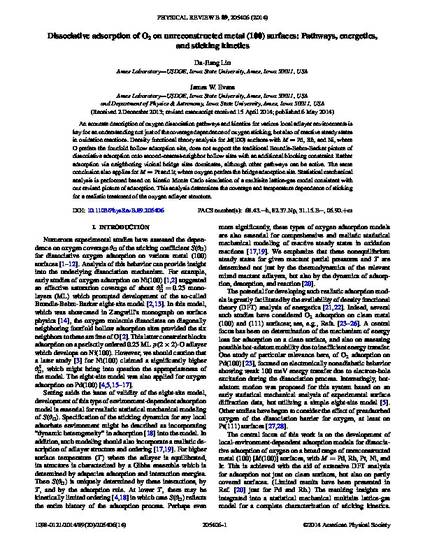
Article
Dissociative adsorption of O2 on unreconstructed metal (100) surfaces: Pathways, energetics, and sticking kinetics
Physical Review B
Document Type
Article
Disciplines
Publication Version
Published Version
Publication Date
5-6-2014
DOI
10.1103/PhysRevB.89.205406
Abstract
An accurate description of oxygen dissociation pathways and kinetics for various local adlayer environments is key for an understanding not just of the coverage dependence of oxygen sticking, but also of reactive steady states in oxidation reactions. Density functional theory analysis for M(100) surfaces with M=Pd, Rh, and Ni, where O prefers the fourfold hollow adsorption site, does not support the traditional Brundle-Behm-Barker picture of dissociative adsorption onto second-nearest-neighbor hollow sites with an additional blocking constraint. Rather adsorption via neighboring vicinal bridge sites dominates, although other pathways can be active. The same conclusion also applies for M=Pt and Ir, where oxygen prefers the bridge adsorption site. Statistical mechanical analysis is performed based on kinetic Monte Carlo simulation of a multisite lattice-gas model consistent with our revised picture of adsorption. This analysis determines the coverage and temperature dependence of sticking for a realistic treatment of the oxygen adlayer structure.
Copyright Owner
American Physical Society
Copyright Date
2014
Language
en
File Format
application/pdf
Citation Information
Da-Jiang Liu and James W. Evans. "Dissociative adsorption of O2 on unreconstructed metal (100) surfaces: Pathways, energetics, and sticking kinetics" Physical Review B Vol. 89 Iss. 20 (2014) p. 205406-1 - 205406-14 Available at: http://works.bepress.com/james-evans/39/

This article is from Physical Review B 89 (2014): 205406, doi:10.1103/PhysRevB.89.205406 . Posted with permission.